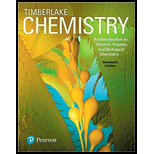
Concept explainers
Write all of the mole—mole factors for each of the following chemical equations:
a.
b.
Want to see the full answer?
Check out a sample textbook solution
Chapter 7 Solutions
Chemistry: An Introduction to General, Organic, and Biological Chemistry (13th Edition)
- For the chemical reaction Sb2S3+6HCl2SbCl3+3H2S write the conversion factor that would be needed to do each of the following one-step conversions. a. Moles of SbCl3 to moles of H2S b. Moles of Sb2S3 to moles of HCl c. Moles of H2S to moles of HCl d. Moles of Sb2S3 to moles of SbCl3arrow_forwardWrite the balanced chemical equation for the complete combustion of heptene, C7H14. In combustion, hcpLcnc reacts with oxygen to produce carbon dioxide and water. What is the mole ratio that would enable you to calculate the number of moles of oxygen needed to react exactly with a given number of moles of heptene? What mole ratios would you use to calculate how many moles of each product form from a given number of moles of heptene?arrow_forwardA student mixes magnesium and hydrochloric acid and a chemical reaction occurs, shown in the equation below. ____ Mg + _____ HCl --------> _____ H2 + ______ MgCl 1.) How many moles of magnesium would you need for the reaction if you had 2 moles of HCl? 2.) How many moles of magnesium would you need for the reaction if you had 4 moles of HCl? 3.) How many moles of hydrogen gas (H2) would be produced if you started with 2 moles of magnesium and 2 moles of hydrochloric acid (HCl)?arrow_forward
- The following materials are reacted together according to the equation below 5.00 moles of KReO4 14.00 moles of H2S 6.00 moles of HCl 2 KReO4 + 7 H2S + 2 HCl → Re2S7 + 2 KCl + 8 H2O How many moles of H2O would be producedarrow_forwardCobalt reacts with water according the the equation below. When 15.66 grams of cobalt is added to an excess amount water, how many moles of cobalt(III) oxide will be produced by the time the reaction is 51% complete? Report your answer with three significant figures. 2 Co + 3 H2O → Co2O3 + 3 H2arrow_forwardNitrogen and hydrogen combine at a high temperature, in the presence of a catalyst, to produce ammonia. N2(g)+3H2(g)⟶2NH3(g)N2(g)+3H2(g)⟶2NH3(g) Assume 0.270 mol N20.270 mol N2 and 0.869 mol H20.869 mol H2 are present initially. After complete reaction, how many moles of ammonia are produced? How many moles of N2N2 remain? How many moles of H2H2 remain? What is the limiting reactant?arrow_forward
- For the chemical reaction: Na3N → Na + N2 How many moles of nitrogen gas are produced when 0.25 moles of Na3N react ? Don’t forget to balance the reaction. a) 0.125 c) 0.25 moles b) 0.50 moles d) 0.75 molesarrow_forward2.56 aluminum foil, Al, reacts with unlimited supply of Oxygen gas produced aluminum oxide, Al203 4Al +3O2 --- 2 Al2O3 What is the molar mass of aluminum, Al, and aluminum oxide. Al2O3 Sig fig: Molar mass AL: Molar mass of Al2O3 b. coefficients chemical eq above ______- moles Al2O3/______ moles Alarrow_forwardCalculate how many moles of NO2 form when each quantity of reactant completely reacts via the following reaction: 2N2O5(g)→4NO2(g)+ O2(g) 7.4 mol N2O5 Express your answer using two significant figures.arrow_forward
- Calculate how many moles of NO2NO2 form when each quantity of reactant completely reacts via the following reaction: 2N2O5(g)→4NO2(g)+O2(g)2N2O5(g)→4NO2(g)+O2(g) Part A 2.8 mol N2O5 Express your answer using two significant figures.arrow_forwardBenzene (C6H6) burns in air according to the following equation shown below. How many moles of O2 are required to react with 0.10 mol of C6H6 2 C6H6(l) + 15 O2(g)→12 CO2(g) + 6 H2O(g)arrow_forwardThe following materials are reacted together according to the equation below 5.00 moles of KReO4 14.00 moles of H2S 6.00 moles of HCl 2KReO4 + 7H2S + 2HCl -> Re2S7 + 2KCl + 8H2O How many moles of H2O would be produced? How many moles of HCl remain at the end of the reaction?arrow_forward
 General, Organic, and Biological ChemistryChemistryISBN:9781285853918Author:H. Stephen StokerPublisher:Cengage Learning
General, Organic, and Biological ChemistryChemistryISBN:9781285853918Author:H. Stephen StokerPublisher:Cengage Learning Introductory Chemistry: A FoundationChemistryISBN:9781337399425Author:Steven S. Zumdahl, Donald J. DeCostePublisher:Cengage Learning
Introductory Chemistry: A FoundationChemistryISBN:9781337399425Author:Steven S. Zumdahl, Donald J. DeCostePublisher:Cengage Learning

